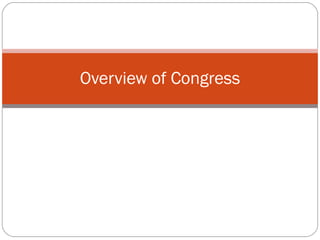Overview of congress
- 2. Ėý
- 3. Senate Leadership President of the Senate Vice President of the United States Cannot take the floor to speak or debate Can only vote if there is a tie President Pro Tempore Leading member of the majority party elected by the Senate itself Acts as president in the Vice-Presidentâs absence Majority Leader and Minority Leader Elected by the party caucus Try to steer the legislative agenda in their parties favor Not an official positions, but a very important one Majority Whip and Minority Whip Assistants to the leaders, chosen by the party caucus Checks with the party members to see how many votes can be counted on for a particular matter
- 4. House Leadership Speaker of the House Most important and influential House member Leader of the majority party and chosen by the House members Speakerâs responsibilities No member may speak until recognized by the Speaker The Speaker interprets and applies all rules, refers all bills to committees, puts questions to a vote, and decides the outcome of votes taken The Speaker names the members of all committees The Speaker signs all bills passed by the House Follows the Vice-President in the line of succession to the presidency
- 5. Party Caucus A closed meeting of the members of each party in each house Meets before every session and occasionally during the session Decide party leadership, legislative agenda and strategy
- 6. Congressional Bills Good bills do the following: Address a problem facing the United States or a specific region Provide practical solutions to this problem; solutions that can be implemented They are clear and provide appropriate money, define crimes, make specific penalties and specify who is responsible for carrying out the provisions in the bill
- 7. Ėý
- 8. Ėý
- 9. Ėý








